May 4, 2007
China Bowl: The Best Al Pastor?
On the way up from Huntington Beach, Kohei and I picked up some fresh, wild-caught shrimp in a small town right before we reached Santa Barbara. If you are familiar with that stretch of coast line, it's the place that used to have the banana plantation back in the day.
Unfortunately, I didn't take any pictures, but the place selling the shrimp was like something you might encounter in Mexico or a rural coastal village in Thailand. I saw no signs advertising their shrimp, only a broken down taco truck converted into a produce stand, which also sold long skateboards.
Kohei inquired if they were the place that sold shrimp, and the young dude cleared some lettuce off of a battered box, and removed the lid to expose some really fresh shrimp. It still had bright pigmentation, and the only smell was of fresh sea water.
I drove off with my mind blown that such a place could exist, hidden from everyone other than the locals right next to the 101. This is what I had grown addicted to in Japan: finding places that no one else knew of that were extraordinary. Since returning, I've found such places, but not nearly as frequently as I did in Kyushu and Kansai.
What was the chances of finding 2 places that surprised me in one day, covering a stretch of California that I have driven through countless times? Well, it was pretty good that day.
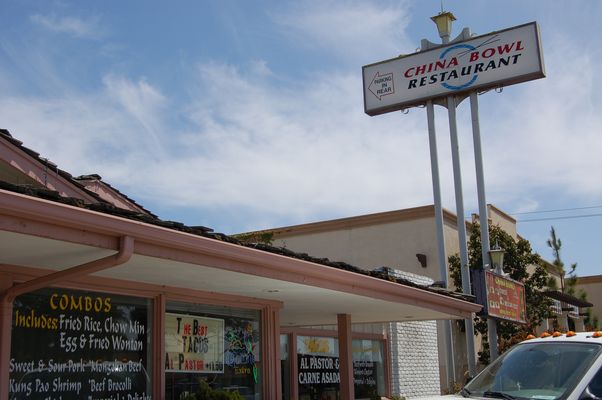
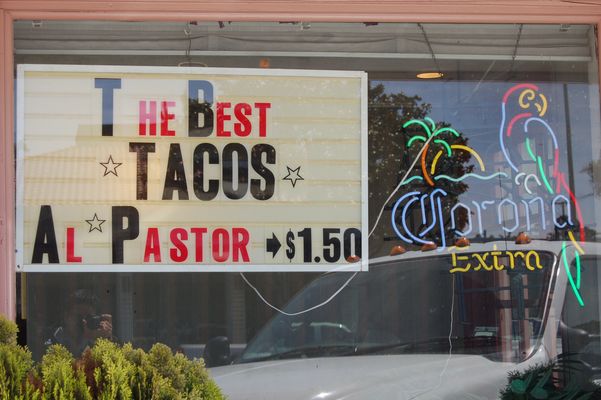
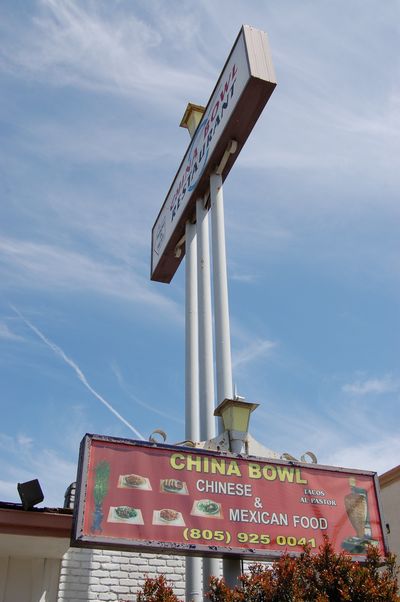
"What do you recommend for lunch?" is a question I've asked Ko on many occasions, and he has never done me wrong. Tri-tip burgers in Long Beach, Pink's Hotdogs, and the best chili fries in L.A. are only a few things that we have enjoyed on an afternoon. This guy knows good food, but I was still more than a bit confused when he recommended a Chinese place for Mexican food.
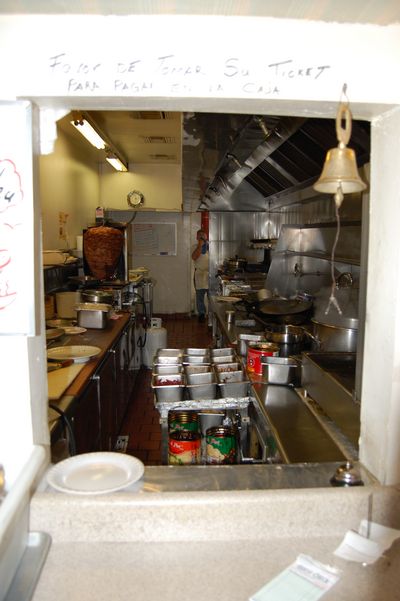
We walked into the restaurant at about 2pm, and there was no one to show us to a seat. Instead, we walked up to a window next to the kitchen, wrote down our order on an order pad. We summoned the cook, and he shaved a seemingly insignificant portion of meat off of the stack, serving us 3 tacos apiece.
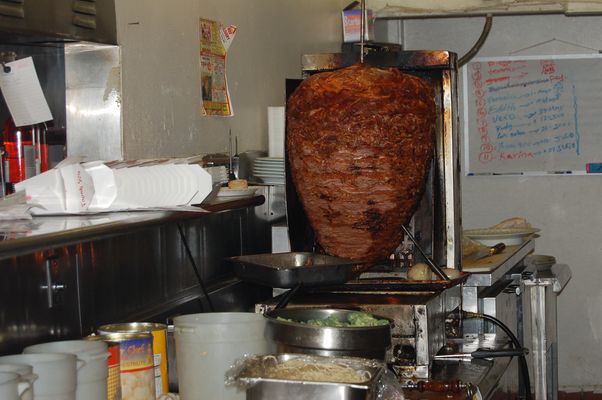
This beautiful ball of sizzling pork reminded me of all of the great chunks of roasting meat I've sampled, notable those of the kebab places in Pike's Place Market in Seattle, of tacos in Mexico, and of Churrasco in Kobe.
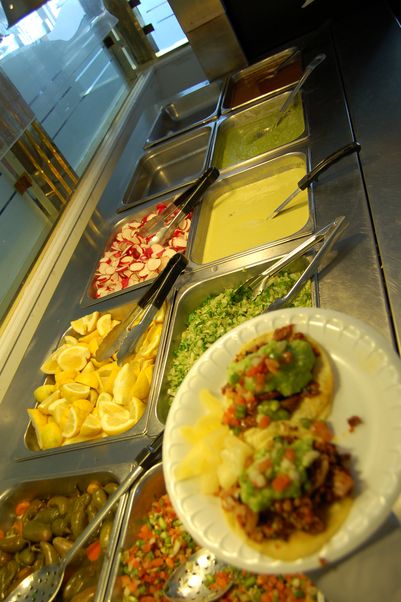
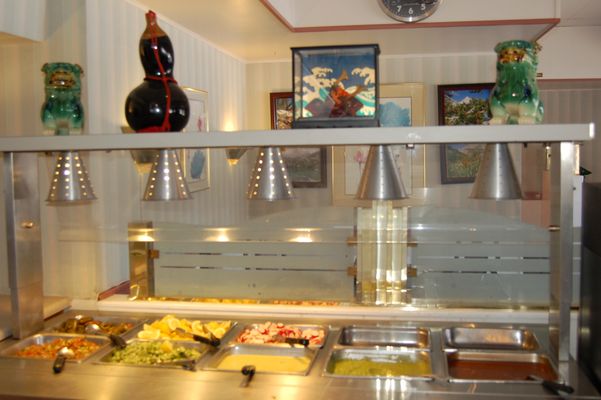
The salsas and condiments were top rate as well. Notably, they served their tacos with a side of canned pineapple that perfectly complemented the tacos. Pico de gallo, cilantro and onions, jalapenos, sliced radishes, guacamole, and other toppings rested underneath two Shisars, a lacquered hyotan, and a samurai helmet display. Could this place be any more awesome?

The owner clearly liked fishing and hiking in the mountains, as he decorated the restaurant with mounted fish and family pictures in the Sierras. I have no idea about the history of this restaurant, but I intend to return and find out. It will give me a good reason to go back and enjoy some of the best tacos I have ever tasted!
On the China Bowl website there is no mention of tacos, but take my word for it: it is well worth your time to stop by this place if you find yourself passing through Santa Maria. Long live Chinese tacos!
June 28, 2004
Cooking With Green Butter
Avocados are only 100 yen right now, and so I have been using them a lot lately. My favorite ways to eat them are sliced with shoyu (California-nisei style), as part of a sandwitch/cheeseburger, or as guacamole. Fresh tortillas are worth their weight in silver over here, but tortilla chips are abundant and cheap and go the best with the guac. I will be experimenting with various indiginous Japanese foods to see if any go well. Here are some proposed dished:
nato, guacamole, and yamaimo with ice cold soba
sushi with a pad of guacamole under the bullet of fish instead of wasabi
grilled, salted salmon with guacamole
curry with pork cutlet and guacamole
basashi (horse sashimi) and guacamole
miso soup with essence of guacamole
guacamole soft cream (soft serve)
guacamole with asse
yakiguacamoleonigiri
tantanmen with guacamole topping
Vietnamese spring rolls with rice vermicelli, sweet grilled pork, Vietnamese pickles, fish sauce, and guacamole (this is not Japanese, but I think it is one of the more promising combinations).
Some are destined for greatness, while others will be fed to unsuspecting friends. I used only ingredients that were readily available and cheap in the middle of Kyushu. Here's my take on guacamole:
2 hass avocados
1/2 tsp. of fresh lemon juice
1 small tomato, diced
1/2 small onion, minced
2 cloves of raw garlic, minced
garlic salt
pepper
cajun seasoning
tapatio sauce
I ate this guacamole with pack of Pringles (sour cream and onion flavor), because sometimes they don't have tortilla chips at the supermarket.
This is a very simple recipe and very easy to make. Caution: using raw garlic makes the guacamole spicy, and will result in breath that would cause one embarrassment in a kimchee factory in Korea.
June 21, 2004
Cooking With Goya
This weekend I cooked with goya(bitter melon) for the first time, and it turned out awesome! I first tried goya in Okinawa as a component in a chop suey-like dish, and made it with the help of a friend. After you try this dish, you might grow to love the bumpy-cucumber-like hunk of bitterness.
Goya Champura
Ingredients:
1 goya, cored and sliced thin into half-rings
1 onion, cut into (half) rings
a few cloves of garlic, minced
one half a loaf of SPAM, chopped into thin slices
one block of firm tofu, cubed
four eggs, scrambled
one teaspoon of sesame oil
one teaspoon of olive oil
two heaping tablespoons of miso paste
one tablespoon of toubanjan (red chili paste)
Directions:
Fry the goya, onions, and SPAM in the oil on high heat, until the onions become translucent and then add the garlic along with the miso and toubanjan and cook for a few more minutes. Add in the tofu and the eggs with some salt and pepper and cook until the eggs are done.
This dish shows off the versatility of spam, in its ability to tame a food as bitter as goya. Like it or hate it, but above all, respect the SPAM.
Note:
Due to the high sodium content of SPAM, I suggest going light on the salt. If you want to get seriously Okinawan, then you should eat this with a slowly stewed pig's foot (this is so f*cking delicious that all negative connotations of pig's feet will disappear once you eat it), grilled lobster and steak, a small, deep-fried red snapper without its filets (basically the head, bones, and tail), and some awamori, aged 20 years (100% kusu, of course!).
For more info on goya, and another goya champura recipe, check this page. Mmmmm... Goya Beer...
June 16, 2004
A Gaping, Unfilled Niche
There are a few things that I used to depend on for everyday cooking and I still use many of them over here, but I sorely miss Mexican food ingredients. I miss the abundance of tortillas, both flour and corn (I can get flour tortillas at Costco in Fukuoka periodically, but it is a pain in the ass). Good cheese is also hard to obtain, because it is prohibitively expensive (except for at Costco, once again). If you want cillantro, you must grow your own, and it will not survive the cold winter of Ubuyama without a heat source (you can obtain it at the Kuju Hana Koen, labeled as "italian parsely", as a potted plant). I also miss frijoles and canned chilli. These are the ingredients that helped to get me through college.
I was excited to find all of the components for making tacos, including cheap avocados, but there was one ingredient I couldn't find- tortillas. I tried eating the taco ingredients on top of rice, but rice sucks as a substitute. The only worse thing I can think of is putting the taco ingredients on a slice of toast! I was so disappointed that I thought about making my own tortillas, and found these instructions. Sorry, that's just too much work for something that I'm used to shelling out 39 cents out for, for a ten pack.
Maybe that's what made eating Mexican food so great when I came back home last Christmas. I love eating tacos, enchiladas, burritos, quesadillas, chimichangas, taquitos, nachos, and everything else that you can get at a taco truck, Tito's tacos, Alerto's, King Taco, and the other mexican restaraunts and taquerias that I remember.
I'm not sure about the rest of Japan, but Kyushu has almost no Mexican restaraunts that I know of, except for Plaza Del Sol in Kumamoto City. This place is pretty good, and the prices are reasonable, considering the rarity of many of the ingredients that they use. THey make decent tacos, burritos, nachos, and other dishes and the cooks are Mexican- again, something truly rare in Japan but not worth mentioning in California. One thing that did surprise me was their pickled vegetables (I forget what these are called in Spanish, help Dad!). The slices of carrots, jalapenos, and whole cloves of garlic are the best I have tasted anywhere.
If you are coming to Japan, and love Mexican food as much as I do I suggest you do two things:
1. Bring your own industrial sized bottle of El Tapatio (or Cholula for all of you rich people).
2. Eat AS MUCH Mexican food as you possibly can for the two weeks preceeding your departure.
June 14, 2004
Lost Bread Topped With Fried Bananas
Everyone knows how to make French Toast, but I consider my version to be top shelf. My favorite thing about FT is that I almost always have the ingredients, and it is a quick meal. Try this version out:
Ingredients:
bread, left out from the night before or toasted to get rid of moisture
eggs
whipping cream
peach schnapps or kahlua
butter
bananas, sliced
maple syrup
sugar
confectioner's sugar
cinnamon
Directions:
Scramble the eggs and add some whipping cream. Also add peach schnapps or kahlua, sugar, and cinnamon. Dip the bread on both sides, allowing it to soak in the egg mixture. Fry on both sides with butter (this is important!) on medium heat (you want the sugar in the FT to brown nicely, but not to blacken- there is a thin line between carmelization and carbonization. if it starts to smoke, you've cooked it for too long or used too strong of a flame).
Next for the topping. Add a generous tab of butter to the pan, and keep the flame at medium high. Carmelize the banana slices on both sides, making sure not to burn them. If you do it just right, they should be a deep, crispy shade of brown and will taste awesome! Powder the FT with cinnamon and powdered sugar, hip up some fresh whipped cream and top the FT with it, along with the bananas and some maple syrup.
This recipe was inspired by my mother, who used to make fried bananas for me and my siblings when we were little, and who also stressed the importance of using butter to cook with. Olive and canola oil have their time and place, but using margerine or some other butter substitute is unacceptable. And don't get me started on the butter-flavored lipids that they squirt onto movie theatre popcorn! Margerine wasn't meant to be eaten in the first place- it was developed to be mixed with gasoline along with other components to make Napalm (I'm pretty sure, but I can't find any sources on the net). Mmmmm... Napalm...
June 8, 2004
Ode To Inaka Ninniku
On a routine after-work drive, deep in the country I spotted an unattended shack with a sign that read "yasai (vegetables), 100 yen". Nestled among the daikon and shiitake mushrooms was a mesh bag containing two choice clusters of garlic. For some reason, the garlic caught my eye, and so I dropped my 100 yen coin into the rusted steel tea cannister (tink!) and drove away satisfied with my transaction.
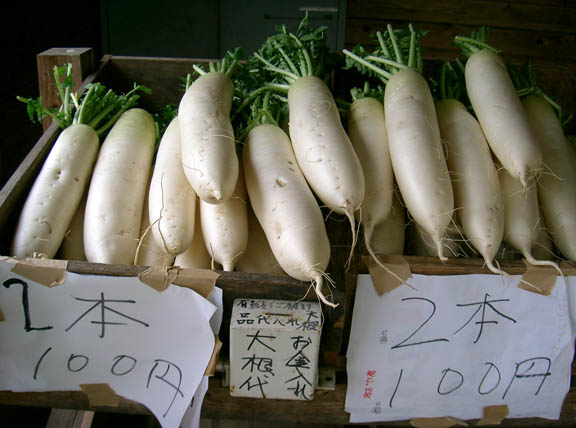
This is the setup I'm talking about. These daikon (giant Japanese radish) are not only ridiculously cheap, but are also fresher than anything you will ever find in Jusco.
Where else in the world can you find high quality produce by the side of the road and buy it based on the honor system? If this was Orange County, or even Kumamoto City, the cash box would be stolen at the very least and the vegetables would be thrown at the passing traffic! When theft does occur out here it is a big deal like it should be, and the cops come out and spend much time and effort trying to do everything they can to help. Out here is one place where I don't harbor negative feelings about the police. It is in their best interest, as part of a tightly woven community of country folk, to do their best job and to be friendly. I understand why cops back home can be (and sometimes have to be) such assholes, but as a result I tend not to like them. It still makes me laugh when I remember going to Baja Fresh with Justin, hearing the worker ask the police officer "would you like beef or pig?" tacos.
Enough on cops, lets get back to garlic. This garlic that I bought was special. It was about the same price as garlic in the supermarket, but it was much superior. One thing that you can count on about country grown produce is that the farmers plant very good varieties because they are eating what they produce. Producing one's own food is such a foreign concept for many people living in places like the U.S. or in big cities, as we are all disconnected from where it comes from and how it is made. My neighbors grow all of their own rice, vegetables, and in some cases chicken, eggs, and meat that they need, and surplus. It is this surplus that they give to their friends, barter, or sell in the booths. So the garlic that I bought from the stall is the same variety that some country family is enjoying as well.
What strikes me about this garlic is that it is so powerful. When I chop up onions nowadays, it is rare for my eyes to water from the fumes. However, when I mince my garlic up into tiny cubes, my eyes sting and well up, despite me wearing glasses. It hurts, but I know that the pain is worth it. The flavor of the garlic is rich and strong and full bodied, but not in an overpoweringly stinky way. Maybe it's just a placebo, but I feel more healthy after consuming it. One more special thing about this garlic is that the skin peels away from the cloves without any fuss. Whoever developed this particular cultivar of garlic knew what they were doing, and did it well.
Talking about cultivars and heirloom species reminds me of listening to Professor David A. Cleveland from U.C.S.B. lecture about the effect of cultivated plants on society and the environment. Professor Cleveland regularly went all over the world deep into the countryside, where people had developed intimate relationships with the crops that they harvested, from Oaxaca, Mexico to Syria. He was quite passionate about the importance of preserving these cherished species not because he anthropomorphisized them in any way, but because these specific cultivars have very useful traits that have been engineered over thousands of years by farmers, specific to their locations and needs. Companies like Monsanto and other biotech firms go into the countryside and get samples of these plants, often giving nothing back to the farmers in return and exploiting this resource, making a huge profit. Why is this a big deal? Because the farmers in these areas are getting doubly screwed. It is because of the farmers and their ancestors that these strains exist, and it has taken them great time and effort to develop and maintain these. The cultivars and their DNA are rightfully the intelectual property of the farmers who developed them. In addition, these big companies sell the bioengineered strains to these farmers, driving many to develop a dependence on them. This leads many farmers to abandon the very crops that the engineered strains might have been developed from, since they tend to be high yield varieties that in the short term out perform the local crops.
The local cultivars are there for a good reason. They are ideally suited to that specific environment and that specific microclimate, and have allowed farmers to produce the maximum yield sustanably over an indefinite period of time. The strain of corn in one village might be completely different from the strain used the next village over due to subtle, yet important differences in hydrology, geology, temperature, or any number of variables.
With the adoption of commercial, all purpose seed, these cultivars are being lost. Unique, valuable genetic sequences that took countless generations to create vanish, all for the pursuit of maximizing profits in the short term (and creating a dependence based on petro-chemicals, depleting the soil, and creating other environmental and socioeconomic problems in the long run). One of the most tragic things about monoculture using the same seed is that it takes away the variety from food. Instead of countless choices, it all becomes the same. I find this loss of flavor, texture, and uniqueness to be truly disturbing.
Luckily, the fields in my neck of the woods are small, ununiform, and terraced. The farmers grow an assortment of different crops, and the people value their favorite strains of vegetables, fruits, and mushrooms. I mean, the farmers do depend on petro-chemicals to raise their crops and produce rice and other products for the mass market, but they also grow the old strains for their personal consumption. I am pretty sure that the future of the wonderful garlic that I ate will be safe in the hands of these country farmers, deep in the heart of Kyushu.
May 27, 2004
This Week's Recipe
I have been enjoying a certain dish lately, so much so that I'm going to post it:
Pork Flavored Garlic Stir Fry
Ingredients:
7 cloves of strong garlic, minced
3 pork chops, cut into bite sized pieces
1/2 large onion, cubed
3 bell peppers (preferably red or yellow, but green can be added for color) cubed
1 tablespoon of sesame oil
1 tablespoon of olive oil
1 tablespoon of shoyu
1 tablespoon of mirin
1/2 teaspoon of hot sauce
Spices:
garlic salt
pepper
montreal steak seasoning
Dipping sauce:
Mix 2 parts of Thai sweet chili sauce to 1 part Shiracha
Directions:
Heat up your pan until it is really hot, and then add the oil, and spread it around the pan. Next, keep the heat on high add the vegetables and braise them for about 2 minutes. Add the pork, garlic, and seasonings, and then add the shoyu and mirin. Cook until the pork has a nice seared color. For best results, keep the heat high, and aim to cook the vegetables so that they are still crunchy, but not raw. Serve over rice, and dip morsels into the sauce. I enjoyed the flavor of the dish both with and without sauce, but you can mix the sauce into the dish as well.
The reason I like this dish is because:
1. It is cheap. Beef is more expensive right now over here. Bell peppers are fairly priced as well.
2. It's fast.
3. It has lots of garlic, but maintains a good flavor balance.
4. I have way much more garlic salt and steak seasoning than I could ever use in Ubuyama (one year of use has only resulted in 1/3 use of Costco sized Lawry's seasonings).
5. I love the smell of sesame oil frying in a hot pan.
May 20, 2004
The Hunger
Right now I'm searching the net for pictures to make a complete phonics lesson, and while looking for "cheeseburger", I stumbled upon this. Seeing this image has awakened the hunger. It is right before lunch so I will be eating shortly, but this will not satisfy my craving for some fresh grilled meat patties and cheese sandwiched between two crispy, soft buns, iceburg lettuce, grilled onions, and a slice of tomato. Might as well splurge and get a large vanilla shake and french fries.
According to the reciept, the thing in the picture is a 12x12 (a 4x4 + 8 patties and 8 slices of cheese, meaning it has a total of 12 patties and 12 slices of mouth-watering cheddar cheese) and cost a mere $10.15. I have only eaten a 3x3 personally, but many friends from high school as well as Justin and Kohei have downed a 4x4, and I think they were full. I don't think that any one person is capable of eating a 12x12. It's just not physiologically possible.
Actually, I think that a regular cheeseburger has the perfect ratio of every ingredient. I the beef and cheese overpowers everything else if you order anything larger than a double double.
If you haven't eaten at In N Out burger, you are missing out. If you are a hardcore In N Out junkie, then you know the secret menu which includes but is not limited to the following:
4x4- 4 patties, 4 slices of cheese
3x3- 3 patties, 3 slices of cheese
animal style- mustard grilled onto the patty
protein style- lettuce serves as the bun
grilled cheese- self explanatory
These are all I remembered off of the top of my head, but you can find the rest here.
If you are truly down, then you have noticed that there are bible verses written on the packaging. If you are like me, then you have not bothered to look them up, but you can find them on the page hyperlinked above.
May 12, 2004
Takana
On the second week of April I was recruited to help process Ubuyama's freshly harvested takana while on my way to the laundromat. I pulled into the parking lot and was surprised to find it being used as a loading dock. I swerved to avoid the scattered pyres of takana and a forklift with a full load (a vegetable that looks like a cross between celery, bok choi, and spinach) and proceeded to unload two heaping baskets full of wet clothes bound for the driers. A farmer approached me and asked for my help. Even though I had only met him a couple of times before, I dropped what I was doing and headed into the warehouse to lend a hand.
Inside I met many more of my students' parents, all relaxing and eating some real country Japanese food. They served me some smoked cod that had so much salt on it, that it was almost painful to taste along with takana musubi and assorted tsukemono. They explained that this fish was a traditional food in Ubuyama. In the old days, before the 57 was built, they could not get fresh seafood, so it had to be heavily salted in order to survive the trip inland. When we finished eating, we got to work.
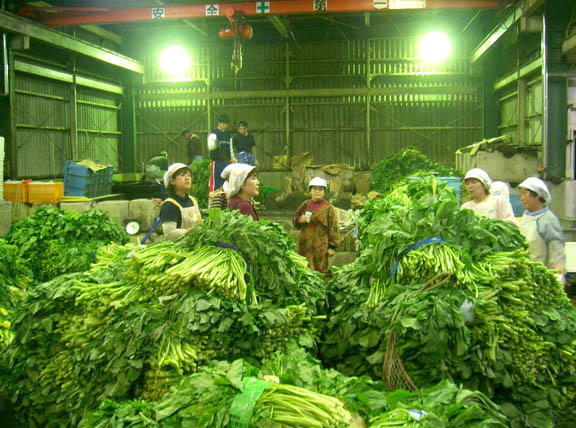
The okusans are taking an ocha break and shooting the breeze in between frantic shifts.

View from behind the forklift.
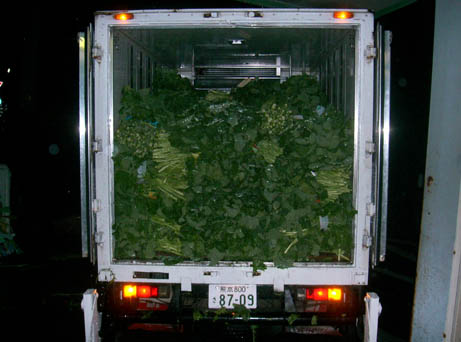
One of the trucks that was bringing in load after load of takana.
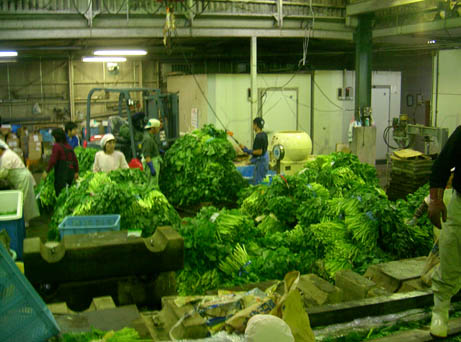
The crane is busy hoisting palettes of takana up to fill the waiting pits, and the rain hammers down on the corrogulated tin roof, mirroring our manic pace.
You can make takana tsukemono in small batches 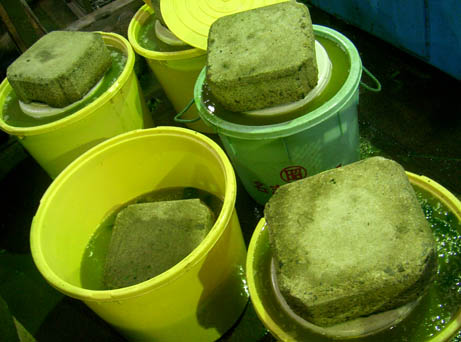 , but we were using industrial sized pools, about 3 cubic meters in volume
, but we were using industrial sized pools, about 3 cubic meters in volume 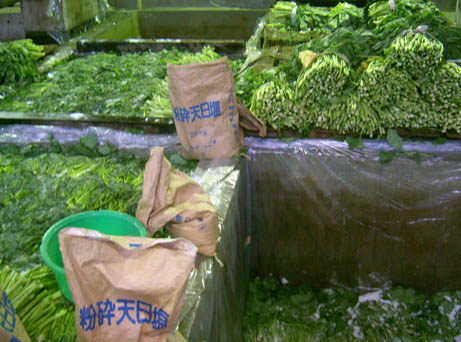 . Two people toss down bales of takana to the workers down below who spread out the takana. Layer after layer of takana is first arranged in lines and rows running perpendicularly to the layer below it. The takana is then amply salted (literally bucket fulls of salt are used, about 1 10 kilo bag per 4 layers in my estimation)
. Two people toss down bales of takana to the workers down below who spread out the takana. Layer after layer of takana is first arranged in lines and rows running perpendicularly to the layer below it. The takana is then amply salted (literally bucket fulls of salt are used, about 1 10 kilo bag per 4 layers in my estimation)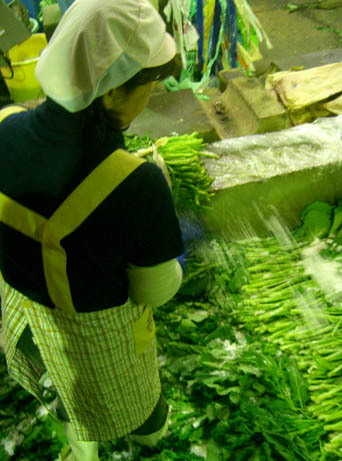 . Next comes the labor intensive part. Everyone jumps in the pit, and stomps on the takana
. Next comes the labor intensive part. Everyone jumps in the pit, and stomps on the takana 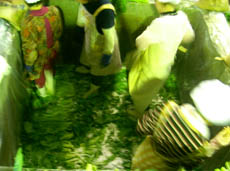 until the bright green leaves of the takana turn dark green
until the bright green leaves of the takana turn dark green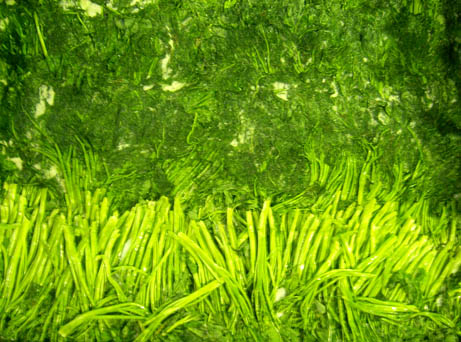 . This is important though: you should not crush the stalk of the takana, only the leaves (or else the takana will not have its satisfying crunchy texture). This part of the process is what I imagine it is like to stomp on grapes to make wine. Yes, part of the brine in the takana comes from the sweat of hard work.
. This is important though: you should not crush the stalk of the takana, only the leaves (or else the takana will not have its satisfying crunchy texture). This part of the process is what I imagine it is like to stomp on grapes to make wine. Yes, part of the brine in the takana comes from the sweat of hard work.
It is astounding to see how many layers of takana can fit into one pit. The average was about 45, and one seasoned obachan said that back in the day, she was able to cram 55 layers of the stuff into one of the vessels. It took about 2 hours to completely fill one of the pits full to the brim. Next, the takana is wrapped in plastic, and about 8 huge tsukemono stones (with the help of a crane) are lowered on the bale 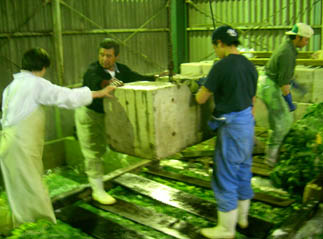 and allowed to sit for a couple of hours. The immense weight further crushes and compresses the takana, and a green brine rises to the surface
and allowed to sit for a couple of hours. The immense weight further crushes and compresses the takana, and a green brine rises to the surface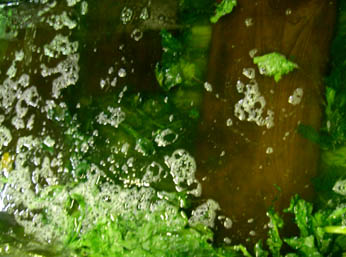 and is siphoned off
and is siphoned off 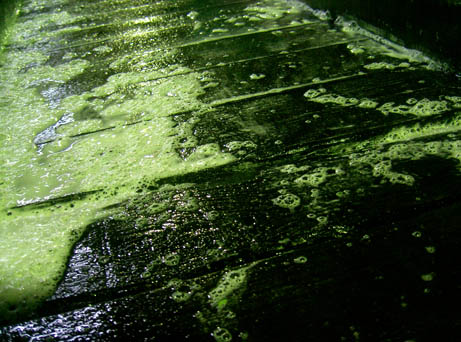 . The takana is either re-wrapped
. The takana is either re-wrapped 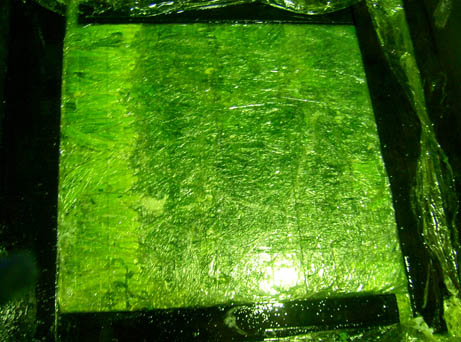 , and allowed to cure for two to three months, or a fresher version is packed immediately the next day.
, and allowed to cure for two to three months, or a fresher version is packed immediately the next day.
The warehouse has about 20 of these bales curing, and the profits (not net) will make the farmers about 5,000,000 yen (a little less than 50,000 dollars). To give you an idea of how much takana was used, these are the plastic strips that bound them into smaller bunches 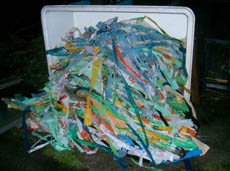 .
.
March 25, 2004
Bento
Calling a bento a "lunch box" doesn't do it justice. It is a lunch box in the sense that sometimes it comes in the shape of a box (and sometimes not), it often has the picture of a cultural icon on the lid (My Little Pony, Ultra-man, He-Man, Hamutaro, and Mr. T. come immediately to mind), and it contains a lunch inside. However, lunch boxes are typically comparatively massive, rectangular in shape, and have a hinged door that clasps tightly shut by two levered latches, located next to the handle of the lunch box. Examples of typical contents found in a lunch boxes include a thermos (usually full of milk or soup), a sandwich, some vegetable sticks, a bag of chips or cookies, a box of juice, and a stick of string cheese. It is also interesting to note that most people stop using lunch boxes after leaving elementary school and switch to the brown paper bag as the vessel of choice for their midday meals. I fondly remember my lunch box, but its contents were always predictable and partly pre-packaged. Opening a bento is more of a mini-adventure.
If you are lucky there may be treasures under the lid of the bento bako, just waiting for you to uncover them at lunch time. Geisha Asobi has some interesting glimpses Japanese culture, including a link to some few highly stylized bento designs. As for a bento that emphasizes equality in form and function, I like these bento made by Mizuko Ito, who examines the question "Are bento an artistic form of motherly love, or are they just another oppresive tool used to shape Japanese society?". Anyhow, you may notice that these bento pictures have been snapped from a cellular phone camera (she also studies the effects that cellphones have on society- pretty interesting stuff), like the ones on Justin's moblog, or the smaller pictures that I was posting up until the demise of the camera on my D251.
This is diverging from the bento theme of this post but still related, in the sense that if your bento contained some undercooked meat or fish you might grow a 28 foot-long friend in your intestines.
March 23, 2004
Memories Of Little Saigon
Visiting Little Saigon, unlike other designated ethnic areas, gives me the feeling that I'm in a place that lives up to its namesake. Short of a trip to the real Saigon, it is as authentic an experience that you will ever get, smack in the middle of the O.C.. It's an island made up mostly of people with black hair and brown eyes and names like Nguyen, Pham, Trung and Minh (and some guy named Dr. Phouck) within the homogenous racial mix of Southern California. You know this place is legit Southeast Asia style, as 90% of the cars in Little Saigon have, at the very least, one obvious dent or scratch. If you're looking for cheap imported goods, look no further than the Asian Garden Mall, full of all sorts of strange smells, cheap knockoffs, and stuff you can't find anywhere else. When you walk in a Vietnamese supermarket, you can see black patches where the linoleum has peeled off. If you order a catfish from the tank, the butcher will grab one by the tail and smash its head into the concrete, wrapping its still quivering body (now that's a fresh piece of fish!) in a pink sheet of butcher paper. And it smells of Southeast Asia: lychee, rotting detritus, urine, etc...
But the main reason to go to L.S. is for the food, namely the Pho Restaraunts.

For all of you wondering what type of sauce is in the green capped bottle in front of Justin, that is called Shiracha and is arguably as versatile a condiment as ketchup is. Now look at the bowl in the bottom of the frame. This is the infamous bowl of Pho (no. 10), the prime suspect for causing my bout of projectile vomiting and diarrhea on Christmas Eve. However, I like the pho so much that I plan on eating it again on my next visit. After all, whats a little projectile vomit and diarrhea now and again. A fair trade-off for eating great food, I say.
Pho is not a complicated dish, and that's one of the reasons why it tastes so good. Its a simple rice noodle soup with a light beef broth, some meat, and assorted vegetables and herbs. I have eaten pho in Japan, Santa Barbara, Seattle, and other random places, but the best pho I have eaten so far is in Little Saigon.
Pho should be eaten with an order of cha gio and a glass full Vietnamese style iced coffee.
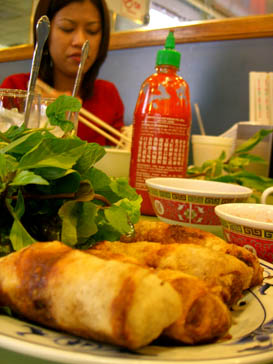 If your cha gio arrive cold, with old vegetables and no fish sauce, you should be very worried. If they come still sputtering out steam with ample freshly washed vegetables and a bowl full of fish sauce, be prepared to cry (from burning your tongue AND from the sublime flavors that your olfactory system will eventually register after the pain fades away).
If your cha gio arrive cold, with old vegetables and no fish sauce, you should be very worried. If they come still sputtering out steam with ample freshly washed vegetables and a bowl full of fish sauce, be prepared to cry (from burning your tongue AND from the sublime flavors that your olfactory system will eventually register after the pain fades away).
The egg rolls above are known as cha gio. The filling is usually seasoned pork and rice vermicelli. They taste great by themselves, but the taste awesome if you wrap them in a fresh leaf of lettuce, along with some Vietnamese pickled daikon and carrot slices, and dip them in the nuoc mam (badass stinky fish sauce- don't be scared!). Eat them right when they come out of the frier if possible, when they are still capable of causing third degree burns. Bite off a piece and use the lettuce to shield your tongue from the intense heat as you inhale and exhale rapidly in an attempt to cool down the morsel. Trust me on this. A Vietnamese meal would not be complete without a cup of Vietnamese coffee. The coffee comes dripping from a cheap metal aparatus, into a small mug holding a generous amount of condensed milk. By the time you are half-way finished with your meal, the coffee should be completely filtered and ready to pour into the ice-filled cup.. I love this coffee because it is as thick as a cappuccino, and creamy and sweet due to the condensed milk. Iced coffee is the only way to go, and the caffeine counter-balances the urge to siesta.
There are many other mysterious, often delicious foods to be eaten in Little Saigon. The sandwitches are cheap and kick major ass (picture a sub sandwitch with butter, pate, roasted pork, vietnamese pickled vegetables, jalapenos, and lettuce), the deserts look like they were taken from the set of Star Trek, and their take on French cuisine is truly refreshing.
So if you do end up coming to Orange County, don't wuss out and go to El Torito, Applebees, or P.F. Chang's after spending all of your time and money at Disneyland. Go to the beach instead and after that get your ass down to Little Saigon, experience an adrenaline rush from almost getting into an accident, and enjoy some truly interesting and delicious food!
As for pronouncing Vietnamese words, good luck. I just point at the pictures in the menu and ask for things politely in English. This may be unfounded, but I get the feeling that these dudes are more likely to spit in your food if they think that you are a prick. At least they're not sneaky about it, like the clowns over at El Torrito.
March 12, 2004
Yet More News Of Spam
The largest Spam musubi in world history will be rolled in Hawaii later this April. Apparently, the Spam Jam restaraunt has successfully branched out into an official chain. It's now only a matter of time before it arrives in the continental U.S., and it becomes another trendy "ethnic food". Now is probably a good time to buy stock in Hormel.
All of this recent talk and news of spam has made me decide to pop open the one can that I have in reserve next week to make kimchee and mayonaisse spam musubi. Ah, good food puts me in the best moods. I think that most people really like food, but I'm beginning to suspect that I like food more than most people do...
Other favorite highly processed meat-based products:
Farmer John's sausages (in both link and patty form)- It is mandatory to use the sausages to scrape up the yolk of a busted sunnyside up egg, picking up some of the fried egg whites on their way into your mouth. Tastes even better when you add the crunch of hot, buttered toast to the mouthful of goodness.
Bologna and bologna-like cold cuts except for head cheese or any other loaf in the "just plain nasty" category (like this for example)- fried with eggs and served on a steaming pile of rice (with gravy sounds awesome- yet to be attempted, but sure to be delicious).
Hot dogs- preferably grilled over a bonfire while listening to oldies and watching the sun set with family and friends in Huntington Beach. Necessary condiments include ketchup, mustard, sauerkraut, sweet relish, cheddar cheese, and scalding hot chili. And what the hell, a little sand adds to the sentimental flavor.
Costco hot dogs- this gets its own listing because Costco hotdogs (traditionally Hebrew National, but also some other kosher brand called something like Sinai hotdogs or Westbank wieners or something) come with a refillable cup- something that is really special to one who has been living in Japan for so long- and also because it was often the last course that we ate when we had college brunch of free samples on Saturday afternoons in college. Yes, one of the secrets of streching that all mighty buck when eating out was taking advantage of free condiments, particularly those which were unsupervised and offered inexhaustible supplies. Take note, young ones.
Braunschweiger- its not only delicious, but its also just plain fun to say! I think that the only way to eat this is on hot toast. This is one of the very few liver dishes that I enjoy eating. The only other liver that I like is horse liver- when served extremely fresh and cold, with some sesame oil and shoyu, it is one of the more surprisingly good types of sashimi that I have yet encountered.
BTW, you can look up all of the meat products that I have listed on this page, if you are interested in seeing what they are made of. I took a good, long look at how much fat and sodium all of them contain, and I can't really say that it had any effect on my appetite whatsoever. I will continue to eat beef despite BSE (although not American as of late), and I will continue to eat poultry products despite the avian flu situation (cooking it makes it safe, or so I am hoping). Making bad choices despite being informed. You can have all the knowledge in the world, but it won't make any difference unless you ACT upon it. Time for a big fat bologna sandwitch!
March 8, 2004
Jelly-Coated Meatloaf
Heh, a restaraunt that specializes in Spam based dishes opened in the Phillipines last year and is doing some kick-ass business. I wonder how my fellow Japanese living in Kumamoto would react to Spam musubi... I think that I will sneak some thinly sliced slabs of Spam in to my next enkai (drinking party) and change them out with the basashi. I am willing to bet that small browned slices of Spam will taste pretty good when coupled with onions that are cut paper-thin, a leaf of shiso, and some thick shoyu.
Why is spam so reviled in the continental U.S. and so celebrated by Asians? I wonder what Europeans make of spam- do Norwegians celebrate spam like their Viking forefathers did? In any case, the reason why I don't eat spam on a regular basis isn't because I don't like it. I just think the price of spam is a bit too high, and I only like to eat a little spam at a time. One thing that really creeps me out about spam, though, is the jelly that helps the loaf to ooze out of the can- watching the loaf work its way out of the canal somehow brings to mind nature documentary footage of wild animals giving birth. After that, I cannot help but feeling a little bit like Kronos eating his young Titan children.
February 12, 2004
Penonpen Ramen
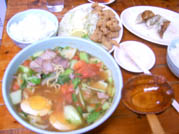
"Penonpen Ramen... Penonpen... Hmmmm." I pondered the katakana as we sat at a small ramen-ya hidden next to Hita's giant koban and in back of a huge pachinko parlor. "Penonpen, penonpen, penonpen.". And then it popped into my head. "Is Penonpen ramen named after a place?" I asked. "Yes, it's the capital of Cambodia" Tomohiro answered.
Tomohiro had drove me and Jaime 2 hours, stopping to sightsee along the way, with this particular ramen-ya as the main point of the daytrip. I have always had great adventures in the company of those who enjoy questing for great food while questing for great food (Kohei is the undisputed master, and everyone in my family is rather adept as well). Food is the only religion which I regularly and piously subscribe to, and there are many gods (this is a topic that would take up multiple posts to fully cover, and so I will stop here and hopefully remember to pick up on this thread later) whom I worship.
Yes, in a small, intimate, professionally run ramen-ya, not unlike the one in the movie Tampopo, I experienced Phnom Penh ramen for the first time. This place (Called Sato ramen-ya if you happen to be in Hita city in Oita-ken) had a great variety of ramen, including shio, shoyu, miso, tonkotsu, and Okinawan style to name a few. Phnom Penh ramen was vaguely "Italian" flavored because of the ingredients in the broth:
Chunks of stewed tomatoes
Celery
Bok Choi
Squid
Pork
Shoyu
I was a bit skeptical whether I would like this type of ramen (my favorite being a good Kyushu style tonkotsu) because it was so loaded with vegetables, but the more I ate, the more delicious it became. The broth also made a slammin' okayu when poured on top of rice. The fried chicken cartilidge (I forget what this is called in Japanese- honyarara karage or something like that) was also very delicious.
Other notable things about yesterday:
Woke up with no hangover, despite drinking too much on Tuesday night.
Went to Kuju Resort with the intent to snowboard, took one look and changed my mind. Saw steam over the ridge, and went to Kuju's jigoku (hell).
After jigoku, spontaneously embarked on said ramen eating expedition.
Took many pictures with sad, unmaintained manga statues along the way.
After lunch at the Sato ramen-ya, took a walk through old Hita looking at traditional crafts and trying to fend off numerous free samples of miso, ume, shiitake-cha, etc...
Took an onsen at Kurokawa.
Ate amazing tabehodai yakiniku (all you can eat barbecue) at the joint at the bottom of Takimurozaka.
Woke up today still full from last night.
Yesterday, I spent a whole day eating, sightseeing, and relaxing and it was really, really good.
December 8, 2003
Top 8 Burgers:
1. Chorizo Bacon Avocado Teriyaki Cheese Burger- home-made, thus perfection (note- there is NO chorizo in Kumamoto)
2. Double tri-tip cheese burger- eaten after bungee jumping with Kohei in the LBC. The juciest, most delicious pure-beef burger ever. EVER!!!
3. Double Kingburger with everything on it and all add-ons: cheese, bacon, chili, ranch dressing, and an egg. While eating one of these, you can actually feel yourself getting fatter- Fat Burger, Los Angeles
4. Masa's Deluxe- Masa's Diner, Kumamoto City.
5. Dick's Deluxe- This company is pretty cool because they help out their workers with their college tuition, according to Mika. Dick's Burgers, Seattle
6. Double Double with Cheese and Grilled Onions "animal style"- In-N-Out (btw, whoever is using the In-N-Out sign in Japan for the Joyfull clone restaraunts should be repeatedly kicked in the nuts, several times a day. Sick bastard!!!)
7. Tommy's cheeseburger with chili fries - Fountain Valley, Ca. Straight up arterial schlerosis.
8. Teriyaki avocado bacon cheese burger- Fuji Burger, Huntington Beach, Ca. This place reminds me of Hawaii, like the Loft, but more of that greasy authenticity.
My Kumamoto Big Kahuna Burger
MASA'S SUPER-DELUXE
![pic_0517[1].jpg](http://www.cosmicbuddha.com/adam/archives/pic_0517[1].jpg)
This burger was two huge patties of real beef (no pork, breadcrumbs, or any other bullshit),cheddar cheese, bacon, tomato, onion, lettuce, mayonnaise, mustard, and ketchup on a grilled bun. It was IMPOSSIBLE to take a real bite out of this burger, so I had to split it in half and eat it openfaced. It was one badass burger.
I had just about lost all hope of finding a good burger in Kumamoto City, until last Thursday. I went out with a couple of friends after our JET meeting to Masa's Diner. The diner kicked ass for several reasons:
1. Good food- the Super-Deluxe was too big for me to finish, and I was starving! In addition, they have locomoco, steak fries, onion rings, chili dogs, and many other truly American classics to try. Bonus for Heinz 57 in glass bottles at every table.
2. Beer from the WC
![pic_0516[1].jpg](http://www.cosmicbuddha.com/adam/archives/pic_0516[1].jpg)
Good drinks- this place has Red Hook ESB and Steelhead(reminiscent of Sierra Nevada Ale) beer. It also has Dr. Pepper and Dad's rootbeer, both of which are hard to find in Kyushu.
3. Its big. It really is. There is room to walk around and to stretch after a gut-busting meal.
4. The staff. The owner, Masa, is really tall for a Japanese man, and he speaks English. This man knows good food. Also, the waitresses are cute, although they do not speak English.
So if you are in Kumamoto and you are tired of eating fish, raw horse, grilled pig intestine, lotus root stuffed with spicy mustard, nato, and all of that other stuff, drop in on Masa's and you will not be disappointed. (Tel 096-352-3118)
If you want good Mexican go to Plaza del Sol (they have real Mexican cooks who have the ganas to make excellent comida).
If you are in southern Aso, check out the Strong Boss. They make a decent burger, and other good food, but the real reason to go is for the atmosphere. Its a biker bar the way you would imagine one to be, in Disneyland. There are no fights and no drugs, and the patrons of the bar won't make you dance to "Tequila" on the table if you knock over their bikes (but they would probably kick your ass as you pointed to the "no fighting" sign).
But remember to enjoy the food that Kyushu is best at making:
Tonkotsu Ramen
![pic_0504[1].jpg](http://www.cosmicbuddha.com/adam/archives/pic_0504[1].jpg)
November 29, 2003
Mayo Otaku
Generally, I like Japanese food. I am down with basashi (horse sashimi), liver sashimi, all traditional food, almost all seafood (except for mutsugoro and kujira, which are the Japanese for mudskipper and whale), and have even developed a positive view of grilled hormone (intestines).
However, sometimes things can get a little out of hand in Japan. Some Japanese people do not seem to grasp the concept that mayonnaise is a condiment best used to make specific dishes. You use mayonnaise to make tuna/egg/macaroni salads. You use mayonnaise in sandwitches or hamburgers. You use mayonnaise as a base to make sauces and dressings. Mayonnaise should only be used in these contexts.
Now, I know that some Europeans and people that have been to Europe like to dip their French (er...Freedom) fries in mayonnaise. I personally do not like dipping my fries this way, because it is disgusting.
But the way that mayonaisse is used in Japan is truly filthy.
At my hoikuens, the teachers like to use plain mayo as their salad dressing. Nastiness.
How would you like a seafood pizza with octopus, shrimp, and clams? What could possibly make this worse?
Mayonnaise
Hmmmm... Is your white rice a little too plain? Why not just drown it in mayonnaise to give it some fatty goodness!
Wow! A hot dog baked into the bun! But whats that white stuff liberally drizzled on top and baked into it?
Mayonnaisse
Mayonnaise doused omelet? Yes Brian, it does exist...
To be fair, Japanese use of mayonnaise can yield some delicious results, but finding complementary combinations between food and this particular condiment have been exhausted. Thats it. Stick to the tried and true recipies.
What do you think you are doing? Don't be creative with mayonnaise. Be creative with beer. Be creative with hot sauce or other sauces. Be creative by creating art. Be creative in how you express yourself. Don't be creative expressing yourself in mayonnaise... It is not bold, nor is it brave. It is stupid and obnoxious. No, not everything is relative, these words are the truth, so shut up already!
November 28, 2003
Thanksgiving In The Japanese Countryside
Living in Ubuyama can really be an inconvenience sometimes. If I were back at home on this Friday, I would be remembering the spectacular dinner that I had eaten yesterday, and would be helping myself to my third helping of leftover deep-fried turkey, stuffing, cranberry sauce, ham, salads (caesar, potato, macaroni, and maybe jello), mashed potatoes, chips and dip, vegetables, and a thick, rich gravy drowning everything.
Not that I can complain, though. I made a couple of Japanese friends panfried steaks and eggs topped with fried garlic, with grilled shiitake and onions in a redwine sauce, with rice and an italian salad! As it was the first time that they had eaten this stuff, it blew their minds (this is common when I cook, but it is usually either extremely good, or extremely bad- though this only happens on average two times a year). Not bad for a meal that took twenty minutes to prepare.
You may have been noticing that I have been talking an awful lot about food lately, and this reflects my state of mind. Japanese food is good, but during the holidays, I need to eat like an American! Yo, supersize that biznitch, and yes I will take the chocolate shake and an extra order of chicken strips and curly fries to start with... 22 days...
November 26, 2003
The Origins Of RocketBowl Saimin
Nestled among my childhood memories of visiting Gardena and West L.A. is one of my Dad taking us to RocketBowl for a big, steaming bowl of Saimin. It is a simple soup that sort of bears a resemblance to ramen, but the noodles are wavy, and the broth is almost pho-ish, served with red ginger and green onions.
Along with waffle dogs, locomoco, various spam dishes, and plate lunches, I remember eating some good saimin on my last trip to Hawaii. Up until that point, I just assumed that Saimin was a hybrid food, the result of a fusion of Japanese, Chinese, and Hawaiian cooking, but I was wrong. I found out where Saimin (for all of you haolies and mainlanders, this is a noodle soup popular to Hawaii) originated: that place is Okinawa, and over there it is known as Okinawa Soba. Bringing things full circle, the Okinawans make their fried rice with Spam! Ah, those islanders, they know how to eat!
November 25, 2003
Kuh..Kuh..Kuh...KkkCold!
Yes, the temperature forecasts have once again plunged below 0 degrees (celcius), and the kotatsu is essentail to ward off frostbitten toes. I can see my breath in my house. But this is only the tip o the iceberg... I know that when I come back from Christmas break, I will need to start leaving my faucets running so that the pipes don't freeze this year. If my towel freezes again this year, I will post a pic of the stiff upside-down U, created from the towel freezing while hanging, that blew my mind last year. Once again, it is time for nabe, hot chocolate, tea, and anything hot.
Come to think of it, the nabe is astonishingly similar to butajiru, but the version that Justin taught to me adds:
beansprouts
kimchee base
ginger
and
chicken or pork
Try this stuff during a really cold night, and you will be thankful.
While I am posting recipies, here is another cold weather favorite:
Adam's French/Viet Beef Stew
This stew recipe is based on a beef stew that I had in Little Saigon while the Cruz and Yoshida parents met up for the first time in God knows how many years. My version kicks just as much ass!
Ingredients:
Lots of spare ribs, like 2 or more pounds
2 Carrots, cubed
2 Potatoes, cubed
Daikon, cubed
Onions, cubed
1 can of tomatoes, whole
tomato paste (thanks for reminding me Justin)
Bullion cubes and water/ beef or chicken broth
Red, red wine
Olive oil
Garlic
Cillantro
Salt, pepper, basil, your favorite spices
Side dishes:
Fraunch Bread, a baguette
Rice
Directions:
Season the spareribs(I prefer using Lawry's seasoned salt and garlic salt) and brown them in the pan with olive oil.
Pour in about two cups of wine, using this to dissolve the residue of the crisped spareribs. Add the vegetables, seasonings, and broth and bring to a simmer.
Let sit for about three hours, occasionally stirring, and adding spices and herbs to taste. Also, add more wine or broth to taste.
By the end of the three hours, the stew should be a nice reddish brown, with fine golden globules of goodness (fat) dancing on the surface of the stew. If the stew is not thick enough, add a mixture of flour dissolved in water, or some other starch.
Serve on a generous portion of rice or dip your baguette into it, and throw some chopped cilantro on top.
This is the best way to enjoy spareribs if you don't have access to an oven. Enjoy.
November 19, 2003
November 16, 2003
Pig Soup
Was the heinous name that was used by one of the teachers to describe lunch. Nah, what butajiru (to be clear, this is similar to dangojiru, but tastes better in my opinion. A dango is a dumpling for all of you people who want to know.) really translates is something more like miso stew with pork. This stuff so good after a 10K run that I ate 3 bowls of it, and still want more.
It is also really easy to make. I will run you through it.
1. Chop all of the following into bite size portions:
Fresh Shiitake mushrooms (dry Shiitake tastes rank compared to the fresh shit!), daikon (giant Japanese radish), carrots, yamaimo (Japanese Mountain Potato. If I may digress, the texture of this potato when grated into a mush is just nasty. This is not passing judgement, it is the unfiltered truth. And to those of you who happen to like this texture: you are all a bunch of sick people who must've delighted in swallowing those big nasty loogies you would cough up when you had a cold. However, when you cook it, it firms up like a proper potatoe and has a citrusy tang to it), thinly sliced pork, hakusui (a bitter-ish form of napa, or japanese cabbage), tofu (bean curd. Damn, calling it bean curd really makes it sound like nasty shit!), konyaku (a jelly-like japanese substance that is opaque, looks purplish-grey, and has black specks. Not really necessary, but adds authenticity), and mochi (rice cakes). Some like to add kabocha (Japanese pumpkin) or satsuma imo (sweet potato), but I think that these ingredients meddle with the texture and flavor of the soup.
2. Make some miso soup. Light miso is best used to bring out the natural flavors of the shiznit. Bring to a boil.
3. Add the ingredients in the proporions which you like the best. I like to add everything in equal proportions, but do whatever you like. Simmer down (control your temper, simmer down, the battle's gettin hotta).
4. After about 30 minutes, pour yourself a bowl. Add finely chopped green onions to top it off, and you have yourself some propah Inaka Ryouri.
Optional: If you were Justin (and you just might be) you would probably add kimchee or kimchee base to make it spicier. If you were my Dad, you would put some protein powder in it. Then you would try deep frying it so that the oil that you used to deep fry the turkey would not "go to waste".
If you don't like pork, you can add chicken, and while it still tastes good, I think it tastes the absolute best with pork. I bet that some of the people out here have added rabbit, bear, wild boar, and the local venemous snake to make, respectively, usagijiru, kumajiru, inoshishijiru, and mamushijiru. I bet they all taste pretty good.
To be fully appreciated, butajiru should be eaten on bitter cold evenings in the mountains in one's straw hut during a blizzard, only after successfully fending off wild bears and wolves with nothing but the crazed look in your eyes, followed by some green tea ice cream for dessert.
September 24, 2003
Marmite Update: Britain`s Version Of Nato?
A Google Search yielded this page. Like natto in Japan, British children are fed this stuff at an early age, so they aquire the taste after rigorous feeding regimens. Natto is typically served as a condiment to rice, as Marmite generally tops toast (the most popular carbohydrate eaten with every meal in said countries).
In the Marmite page, this is a suggestion of a possible use for this particular "savoury spread":
...Marmite is very effective as a topical ointment in the treatment of haemorrhoids.
And I'll leave it at that...
Is This Stuff What British People Eat???
![pic_0425[1].jpg](http://www.cosmicbuddha.com/adam/archives/pic_0425[1].jpg)
Yesterday was a free day. The birds were singing, there were "Ferris Bueller clouds" in the bright blue sky, and a gentle breeze, and so of course I got sick the day before and had to stay at home. But this turned out to be a productive day nonetheless. My place was really messy, so I spent most of the day sorting, organizing, and tossing stuff in the garbage. As I was going through, discarding things in the kitchen that had grown a layer of grey mold (everything- I am not even exagerating) I found this jar of Marmite. Contains various vitamins, 100 percent vegetarian, yeast extract... this looks like something that my father would recommend to treat you for whatever might be ailing you at the moment.
So I unscrewed the grimy yellow cap, and was treated to a whiff of stuff that smelled like a mix of Kyolic (fermented garlic infusion of nastiness), vinegar, and Karo syrup. It was thicker than honey, and had the color of spoiled chocolate pudding. Surprisingly (maybe not really), no mold had grown on this. Even if it had, this stuff could not be any nastier that it was in its natural state.
I know Brits eat some strange stuff. Steve's Toad in the Hole and other lard filled dishes are proof of this. I mean, are you supposed to find pubes in this dish traditionally, or was that just a special treat created in honor of Pete? Anyways, what did Harvey (my predecessor) use this stuff for? Since it was in the kitchen, I can only assume he ate or drank it in some form. I was thinking, are you obligated to eat disgusting things if you are a vegetarian? I think if I were vegetarian, I would opt not to eat Marmite, even if it made me a pseudo-vegetarian, and all the other vegetarians looked down on me (while enjoying a heaping tablespoon full of stinky goodness). I find the other argument, that it contains vitamins, not sufficient to get me to put this stuff in my mouth. I prefer my vitamin fortified Froot Loops and Kix thank you very much!
Has anyone eaten this stuff? If so I am curious to know:
1. Why?
2. How?
3. Would you ever do it again?
4. Is this stuff big in the U.K.?
5. Is it traditionally served with pubes?
September 22, 2003
Inaka Tempura (Is What The Kanji Below Reads)
In English, "inaka" means "country". I live in the cho-inaka (or uber-boonies, for you non Japanese speakers).
![pic_0424[1].jpg](http://www.cosmicbuddha.com/adam/archives/pic_0424[1].jpg)
My village is so inaka that the local restaraunt doesn't even make shrimp tempura. Nonetheless, this tempura kicked some major ass! It was every type of vegetable and mushroom tempura conceivable piled into a huge mountain of oily goodness (I am still trying to decide if this would be considered a healthy meal or not), and I was unable to finish all of it! Is this the equivalent of country style biscuits and gravy? The Japanese still have much to learn in the ways of fattening and unhealthy foods.
September 2, 2003
The Last Meal
![pic_0193[1].jpg](http://www.cosmicbuddha.com/adam/archives/pic_0193[1].jpg)
You have NO idea how good this tasted after eating only burgers from Mos, Mac, Freshness, and occasionally Lotteria for over 8 months! I would have paid 20 bucks for this awesome set: Double Whopper with cheese, Large fries, Large Drink! What is the first thing I am going to do when I get home? I will make a circuit of In N Out, followed by Alertos, then dash over to Tommy's, followed by Claim Jumper and Islands. Then I will visit J&J's house of subs, the Indian place next to J&J's, Rally burger, Fuji burger, Arby's, and Rubio's. In the early morning hours I will go to Jack in the Box, of course!
No wonder Japanese are so skinny- they have no real good burger joints...
![pic_0496[1].jpg](http://www.cosmicbuddha.com/adam/archives/pic_0496[1].jpg)